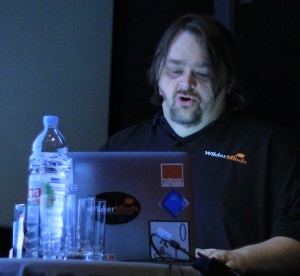Tag: 'entity framework'

I get tagged in a lot of discussion about Dapper vs. Entity Framework. This feels like nHibernate v. Linq2Sql redux. Well, I think about it very differently.

If you're using .NET Core 3 and Entity Framework Core 3 together, you're probably using the EF Tools too. I've been running into an odd issue with it and wanted to share what is going on.

I've had a great time this week attending two events and talking about things I love: .NET and Vue.

I was reading my newest issue of MSDN Magazine and came across Julie Lerman's great article on how to configure Logging in Entity Framework Core. While this is great information, it only covered logging Entity Framework Core from a non-ASP.NET Core project so I figured I'd explain how to do it in ASP.NET Core.

If you didn't notice, Entity Framework Core 2.1 has a new way to support seeding your databases with a method called HasData. Julie Lerman has a great new Data Points column in MSDN that explains how a lot of it works.

I know I am not going to make everyone happy with this post. I've been hoping to not have to make this post, but Entity Framework Core has finally added support for Lazy Loading, so it's time.

Nothing starts a new year like a new skill or two. A couple of months ago I released a new Pluralsight course on building a website using ASP.NET Core 2.0 and Angular.

With the New Year coming, I thought I'd look back at the last year in my life. Warning this is going to be technical and personal, that way I can turn 50% of the people off with every sentence...just a different set of people with every paragraph ; )

In my ASP.NET Core 2.0 Pluralsight course, I specifically teach how to build DbContext classes and the POCO classes that go with them. But I've been getting many questions about how to work with existing databases, so I thought I'd explain it in a blog post.

As many of you know, my recent course on Pluralsight dealt with Best Practices in ASP.NET: Entities, Validation and View Models. As I’ve worked with clients, there seem to be a non-ending list of ways to deal with data in ASP.NET.

For my upcoming course, I have a decent sized example that I’ll be teaching from. In the process of watching ASP.NET 5 go through the sprints, I have to upgrade the project at every step. I feel at some point I should be getting better at dealing with the sprints, but not yet ; )

NOTE: This post has been updated for changes in Beta 7 and later.

In this second post in my six-part series on ASP.NET 5, we’ll take a look at how your ASP.NET 5 applications will be configured upon startup. The startup in this new version of ASP.NET 5 is very different, but hopefully is clearer and easier to debug. At least that’s my impression so far.

Are you getting ready to build a new website? Are you interested in shortening your development by using Bootstrap, AngularJS, Azure and ASP.NET? If so, my new course might be just for you.

Url: http://msdn.microsoft.com/en-us/library/ff84745...

Url: http://msdn.microsoft.com/en-us/ff472347.aspx

Url: http://wilderminds.blob.core.windows.net/downloads/MVVMExample_RIA...

Url: http://thinqlinq.com/Default/Entity-Framework-S...

Url: http://blogs.msdn.com/adonet/archive/2009/04/04...

Url: http://www.simonsegal.net/blog/2009/01/20/linqp...

Url: http://www.silverlightshow.net/shows/Consuming-...

Url: http://code.msdn.microsoft.com/EFExtensions

Url: http://www.silverlightdata.com

Data is a funny business. While at the moment I am spending a lot of time teaching Silverlight, my passion still lives in the data. I was brought up on Minisystems (Multi-user CP/M and the like) where you were dealing with something like a database (though we didn't have that as firm a concept as you might think). Later I did quite a lot of desktop database development starting with dBase II (yes, I am that old), Paradox, Clipper, FoxPro and even Access. That naturally led to client-server and N-Tier development. Throughout all the time its become exceptionally clear how much data matters to most applications.

The Entity Framework "No Confidence Vote" is a couple of days old now. I wanted to give the Internet a couple of days to chew it over and figure out where it really fit into the big picture. If you follow me on Twitter you may have seen some back and forth between Scott Belware and I recently. Most of this back and forth has been about his attacks of the Microsoft community (attacks of the technology or even the company are fair game as far as I am concerned). Getting personal by accusing me, the Microsoft community or even individual EF Team member's directly seems petty and unnecessary.

I've known Julie Lerman (or is it Julia these days ;) for a long time now. She's an excellent resource for everything data related. In particular she's been keeping up with the Entity Framework and ADO.NET Data Services (formerly Astoria) updates in .NET 3.5 and VS SP1 Beta that was just released this week. If you are upgrading projects (like I am), she has two excellent blog posts about how to upgrade your projects:

Over the past week there have been a flurry of new projects coming out of Microsoft, mostly in the form of CTP's. I've been downloading like crazy and will likely be discussing my experience with them in the coming week. In case you missed any of them:

Url: http://msevents.microsoft.com/cui/EventDetail.a...

Url: http://blogs.msdn.com/dsimmons/archive/2007/09/...

Url: http://wilderminds.blob.core.windows.net/downloads/testef.zip

Url: http://blogs.msdn.com/adonet/archive/2007/07/02...

Url: http://www.theserverside.net/tt/articles/showar...

Url: http://www.microsoft.com/downloads/details.aspx...
